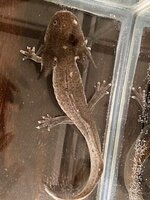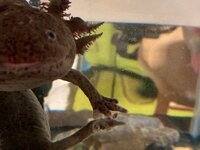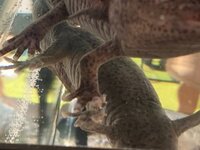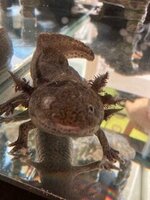MerlinTheAxie
New member
Hello axolotl community! My 8-year-old axie, Merlin, has not been eating as usual since November 2020, and we're now in January 2021. We usually feed her fresh salmon and tilapia, which she loves, but she stopped eating in mid-November, and it took until mid-December to get her to eat a tiny piece of shrimp. She's essentially been fasting for a few weeks now. We tried feeding her other types of foods, such as yellow fin tuna and shrimp, and she only ate that one piece of shrimp as mentioned previously. We also tried different strategies for delivering the food to her, but she refuses to eat and swims away from the food or shakes her head to get away from it. We checked all the water conditions- water temp, ammonium, nitrite, nitrate, pH, high pH, and everything looks good now. Previously, the ammonium was high, and we thought she had ammonium poisoning, so we moved Merlin into spring water instead of her usual dechlorinated tap water, which made no difference. Then we tried adding a treatment to convert the ammonium into a non-toxic substance, but she's still not eating, and in the last two weeks, she developed an awful fungal infection. At least, I think it's fungus. There is fungus covering her eye (so heartbreaking to see) and there is fungus that is surrounding her fingers and fingertips, which have been rotting off (so tragic...insert crying emoji). The fungus is also in her gills. We tried a salt bath as recommended, which seemed to loosen the fungus, and we were able to remove one layer of fungus from her eye by gently caressing the eye with a q-tip. However, we noticed when she was returned to her newly cleaned home tank, her slime layer started peeling off into the water. We decided not to proceed with the salt bath, and gave her a break for two days, and instead did daily black tea baths. Then, we moved her into her freshly cleaned home tank and added Indian Almond Leaves to help her slime layer and skin recuperate while also combating the fungus, which they seem to have done. The fungus is still there though, and it grew back on the eye. She has also been swimming up to the top of the tank and blowing a large bubble...she does this when stressed about us trying to feed her, which we attempt every day, and also when we tried to use a q-tip to remove loose fungus. Merlin is still moving and responsive, but her health is deteriorating--her fimbrae have diminished in size, her fingertips are rotting, she doesn't eat, and she has this pesky fungus on the gills, fingers, and eye. I've added some images to help in diagnosing her and suggesting treatment plans. You'll notice in the images that Merlin has some white patches on her skin and a large black patch on her head...her pigment has been changing as she aged. The white isn't fungus, but maybe that's a sign of a deeper issue and not just aging as we suspected?? What do you think? Any ideas on what she has overall? Maybe ammonium poisoning that led to a weakened immune system due to lack of eating, and finally this led to a fungal infection...??
Some tidbits about the tank conditions in case this helps- Merlin is housed solo, and no living plants or animals are in the tank with her. We do a 100% water change every week, and now, we've been changing the water even more often. Merlin lives in a 20 G tank, and we tried to move her to a 40G tank, but since she isn't well, we decided to keep her in the 20G for now, and turned it into a hospital tank. The water temp is kept at a regular 65F. Water conditions appear good now, although I'm not confident about the ammonium levels... We change the filter weekly, and we've added an ammonium sponge to the filter to help balance ammonium levels.
Possible treatment plans- We wanted to try alternating from a salt bath to a tea bath (1 day salt, 1 day tea), but I'm afraid to put her back into salt since it has contributed to damaging the slime layer as she isn't healthy enough to deal with the harshness of the salt. She seems to like the tea and almond leaves though. We ordered some Kordon Methylene blue, and I saw someone suggest putting 3 drops of it/gallon water. I was thinking of trying this, but what do you all think? How long should she be in that treatment? The instructions on the bottle say to put teaspoon amounts for fish, which seems to be a lot, and they leave fish in it for a 10-second dip.
We've had Merlin for 8 years now, and she hasn't had an illness last so long till 2020 (of course it would be 2020...ugh). Interestingly, we've noticed that she stops eating every November since we've had her, but she always seems to go back to eating after a few days, and the most she's fasted was 3 weeks, but this is going on for months now, and we're out of ideas and very concerned. I would take her to a vet, but in the past, I've spent lots on a vet and all they did was take selfies with Merlin (hehe) and tell me to get the water conditions right. Side question- Has anyone noticed that their axolotl stops eating at an regular time per year, or is that just Merlin? We think it might perhaps be a change in the water that comes from our city, since we use dechlorinated tap water. We're not sure.
Thanks in advance for reading this ultra-long msg! My apologies for that. We're hoping we can save little Merlin's life. Hope you can help through your suggestions!
Some tidbits about the tank conditions in case this helps- Merlin is housed solo, and no living plants or animals are in the tank with her. We do a 100% water change every week, and now, we've been changing the water even more often. Merlin lives in a 20 G tank, and we tried to move her to a 40G tank, but since she isn't well, we decided to keep her in the 20G for now, and turned it into a hospital tank. The water temp is kept at a regular 65F. Water conditions appear good now, although I'm not confident about the ammonium levels... We change the filter weekly, and we've added an ammonium sponge to the filter to help balance ammonium levels.
Possible treatment plans- We wanted to try alternating from a salt bath to a tea bath (1 day salt, 1 day tea), but I'm afraid to put her back into salt since it has contributed to damaging the slime layer as she isn't healthy enough to deal with the harshness of the salt. She seems to like the tea and almond leaves though. We ordered some Kordon Methylene blue, and I saw someone suggest putting 3 drops of it/gallon water. I was thinking of trying this, but what do you all think? How long should she be in that treatment? The instructions on the bottle say to put teaspoon amounts for fish, which seems to be a lot, and they leave fish in it for a 10-second dip.
We've had Merlin for 8 years now, and she hasn't had an illness last so long till 2020 (of course it would be 2020...ugh). Interestingly, we've noticed that she stops eating every November since we've had her, but she always seems to go back to eating after a few days, and the most she's fasted was 3 weeks, but this is going on for months now, and we're out of ideas and very concerned. I would take her to a vet, but in the past, I've spent lots on a vet and all they did was take selfies with Merlin (hehe) and tell me to get the water conditions right. Side question- Has anyone noticed that their axolotl stops eating at an regular time per year, or is that just Merlin? We think it might perhaps be a change in the water that comes from our city, since we use dechlorinated tap water. We're not sure.
Thanks in advance for reading this ultra-long msg! My apologies for that. We're hoping we can save little Merlin's life. Hope you can help through your suggestions!




